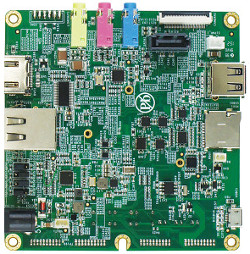Android-based "Brillo" IoT OS arrives with hacker SBC support
Oct 27, 2015 — by Rick Lehrbaum 5,045 views [Updated: Oct. 28] — Google launched developer access to its lightweight, Android based “Brillo” OS for IoT, which initially supports a trio of ARM, Intel, and MIPS hacker SBCs.
[Updated: Oct. 28] — Google launched developer access to its lightweight, Android based “Brillo” OS for IoT, which initially supports a trio of ARM, Intel, and MIPS hacker SBCs.
Google launched a Brillo developer portal today, where code, development tools, and documentation for the Android-based Brillo embedded OS for Internet of Things devices can obtained. For now, gaining access to the portal’s goodies requires completing a short registration form and waiting for an email invitation.
Brillo is a lightweight, open, extensible, Android-based operating system that’s been tailored to the requirements of thinly-resourced IoT devices and their applications. Brillo works in conjunction with Weave, an open, standardized communications protocol that supports various discovery, provisioning, and authentication functions. Brillo can be configured to run within resources as small as 128MB of flash and 32MB of RAM, according to Timothy Jordan, Senior Staff Developer Advocate, Google.


Overview slides: Brillo (left) and Weave
(click image to enlarge)
“Our vision with Brillo is to bring the simplicity and speed of software development to hardware by joining together three things,” explains Google on the Brillo portal page. “First, an OS based on Android. Second, core services that enable a great getting started experience and allow you to operate at scale. Third, a developer kit with tools to build, test, and debug your solution.”

Some typical IoT management app screens
(click images to enlarge)
“Brillo brings the simplicity and speed of software development to hardware for IoT with an embedded OS, core services, developer kit, and developer console,” adds Google.
— ADVERTISEMENT —
“Made for Brillo” hardware kits
Google’s launch of the Brillo developer portal today was accompanied by a series of “made for Brillo” announcements from hardware partners. The announcements span the range of CPU architectures that can support the Android-based Brillo IoT OS — namely, Intel, ARM, and MIPS. The initial “made for Brillo” hardware kits for these three architectures are described briefly below.
- Intel architecture — Intel announced in a blog post that it would be offering an “Edison Kit for Brillo” hardware kit. The Intel kit appears to be identical, from a hardware perspective, to the “Intel Edison Kit for Arduino” that’s shown below.

Intel’s likely Edison Kit for Brillo
(click image to enlarge)
Assuming our hunch the Intel Brillo kit is correct, it consists of an Edison IoT module plugged into a baseboard that offers convenient, Arduino-style expansion compatibility. “Brillo… offers a holistic approach to the IoT solution landscape,” states the Intel blog post. “Brillo brings security, local and inter-device service compatibility, and a modular approach to system components.”
- ARM architecture — Although there are numerous ARM processor suppliers, Freescale is first out of the chute on Brillo. In a blog post today, Freescale announced that its initial Brillo development hardware will consist of the Pico i.MX6UL COM and Dwarf baseboard from Technexion, one of its development hardware partners.


Pico i.MX6UL COM (left) and Dwarf baseboard
(click images to enlarge)
Technexion’s Pico i.MX6UL COM is based on Freescale’s recently announced “high performance, ultra-efficient” ARM Cortex-A7 based i.MX 6UltraLite SoC. “This combination will deliver a platform that will radically extend the number of secure connected embedded devices that can communicate together,” states Freescale in its blog post. “Brillo extends the Android platform to all your connected devices, so they are easy to set up and work seamlessly with each other and your smartphone,” adds Technexion on its Brillo support page.


A single baseboard design can support Pico i.MX6UL or Edison modules interchangeably
(click images to enlarge)
Interestingly, Technexion designed its Pico i.MX6UL COM to fit into Intel Edison sockets, so that in some designs the two IoT modules can be used interchangeably on a common baseboard. As shown above, the two modules implement a common baseboard connector and two-hole mounting pattern, with the ARM module providing a superset of interfaces and mounting holes.
- MIPS architecture — Imagination Technologies announced in a blog post that its soon-to-be-unveiled Creator Ci40 development board will be fully Brillo compatible.


Model of new Creator Ci40 SBC (left) and block diagram of new MIPS SoC
(click images to enlarge)
The Creator Ci40 SBC is based on an as-yet-unannounced “IoT-oriented” MIPS SoC that will be formally introduced in conjunction with the Creator Ci40 SBC’s official rollout next month. Regarding the mystery SoC, a recent Imagination blog post states that “the brand new chip at the heart of Creator Ci40 is based on an IoT IP subsystem that has been engineered from the ground-up for the Internet of Things market.”
The video below gives a short introduction to Brillo, aimed at developers.
An introduction to Brillo, the OS for IoT
Further information
More details regarding Google’s Brillo IoT OS and Weave protocol may be found at Google’s Brillo and Weave developer portals.

Please comment here...